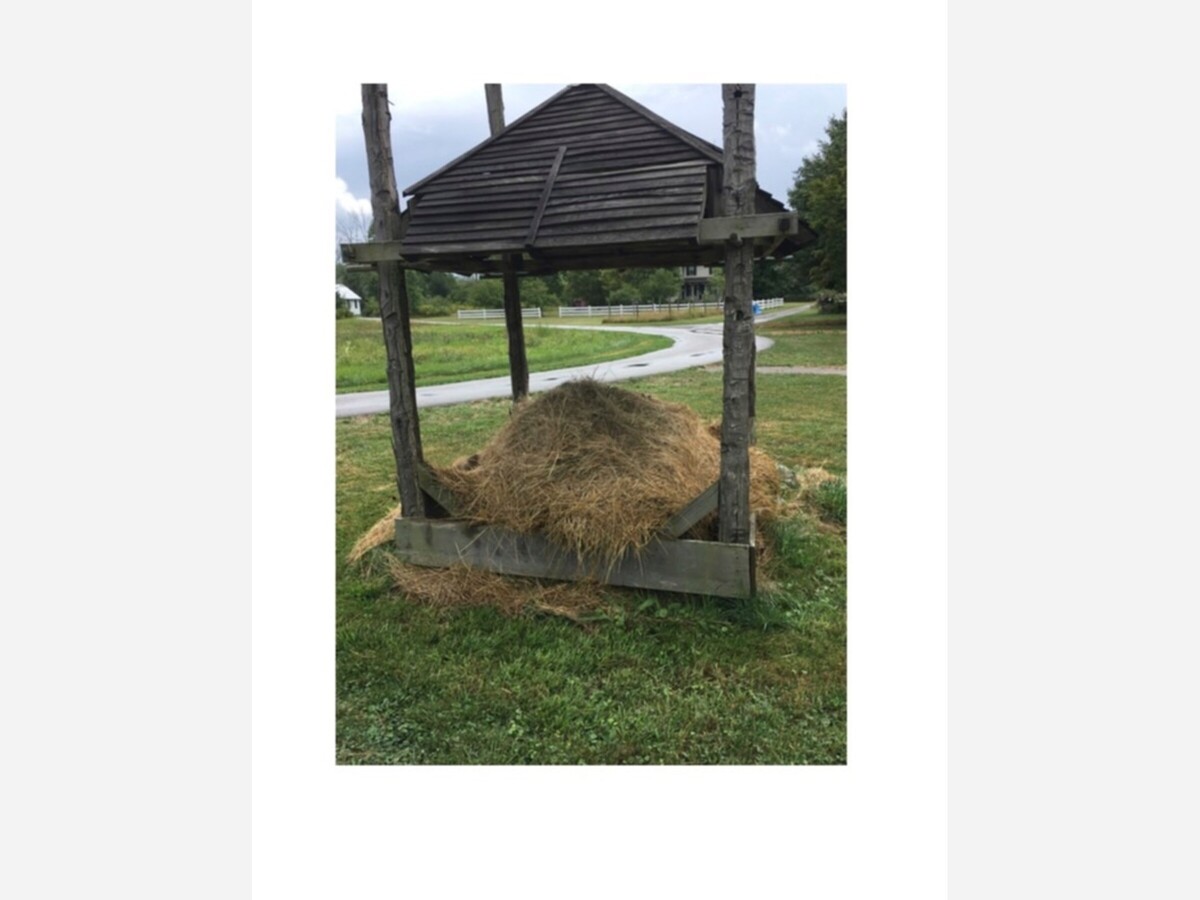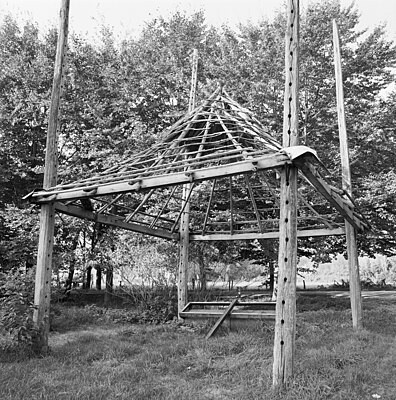Image

by Bob Wood*
One of the pleasures of researching is discovering aspects of local history that are, to me, completely new. One such topic described the once common practice of using white sand as a floor covering. I had never heard of that before. The hay barrack, is one that was likewise new to me.
The barrack, it turns out, was little more than an adjustable roof for a hay-stack. Barracks were also used to shelter grain sheaves until they were thrashed. Colonial Dutchmen lacked the large Swiss bank barns built here universally during the nineteenth century
Apparently found everywhere in the Mid-Atlantic region, hay barracks were a type of farm building consisting of just four posts (with holes for pegging) which supported a light weight roof that could be raised or lowered as needed. Open on all four sides the barrack served to keep dry a hay-stack or a similar stack of straw or grain sheaves while allowing air circulation to prevent mold and spoilage.

Hay barracks were found on many, if not most, farms around here in the Colonial and post-Colonial periods. None are now known to exist in Pennsylvania; although informants tell me that they are still common throughout Holland and much of Europe. Indeed, a late one built in this area was on a small farm at the intersection of Kurtz road and Swamp Pike in Fruitville. There in the late 1940s a Displaced Person, refugee from World War II, set about building a farmstead as he had known from his homeland. This farmstead included a hay barrack which stood until the early 60's.
The term “hay barrack” is English, of course, but its etymology is unclear. It has nothing to do with the term “barrack” as the sheltering place for soldiers. The term is perhaps derived from the Dutch (not Pennsylvania Dutch) hooi-berg: hay-rick; or some other derivative of “rick”---an outdoor or makeshift mow. The source of the Pennsylvania Dutch term for hay barrack, Schuttscheier, is more clear. Schutze means to shelter and Scheier means barn; hence, Schuttscheier--- shelteringbarn.
An early primary source mentioning a barrack is an entry in The Journals and Papers of David Schultze from July of 1756. There Schultze notes 900 sheaves of rye brought into the “Shot Sheuer.”
A good description of a hay barrack can be found in a 1787 letter written by Mrs. Mary Capner in New Jersey to relatives in England: “Barracks are a building I have not described to you, tho I noticed them at the first coming into the country. Tommy has made one for his Bro. It has four poles fixed in the ground at the distance of fifteen feet in a square. The poles are [hewn square] fifteen feet or more at top and five feet at bottom unsquared. This is all above ground. In the square part of the poles there are holes bored through at the distance of twelve inches big enough for a strong iron pin to be put through four wall plates which are …[mortised]… at the ends, then some light spars are put upon the wall plates and thatch upon them. When it was only five feet from the ground, the room can be raised at pleasure 21 feet or any distance from the ground between that and five feet. These are to put hay or any kind of grain under and the roof is always ready to shelter it from hasty rains which are common here in summer. Those that have only two cows have the bottom part boarded at the sides and a floor laid over and the hay at top and the cows stable under.”
In similar fashion, Peter Kalm’s Travels in North America contains a 1749 entry as follows: “…Many people, especially in the environs of Philadelphia, had haystacks with roofs which could be moved up and down. Near the surface of the ground were some poles laid, on which the hay was put, that the air might pass freely through it. I had mentioned before that the cattle had no stables in winter or summer and were obliged to graze in the open air during the whole year. However, in Philadelphia, and in a few other places, I saw that those people who made use of the latter kind of haystack, that with moveable roofs, commonly had built them so that the hay was put a fathom or two above the ground, on a floor of boards, under which the cattle could stand in winter when the weather was very bad.”
We are indebted to Alfred Shoemaker and other twentieth century researchers and writers who documented the fast-vanishing farmsteads and buildings such as hay barracks.
*An inspiring Jack of all trades, master of many, Bob Wood serves as Studio B's Gallery Adjunct when he's not busy doing everything else! Writer, artist, potter, historian, and volunteer. Bob began his career as an artist following his retirement from teaching Language Arts. Bob is a popular speaker; local history is his niche. Bob has published four books on local history.